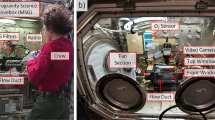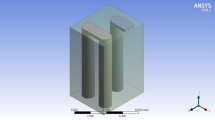Abstract
The Hencken burner flame is often used in combustion laser diagnostics as a calibration flame because of its near adiabatic condition. For a fast burning H2 flame, it can tolerate high flow rate and the flame is indeed near adiabatic; however, for a slow burning CH4 flame, the flow rate is not always high enough to maintain near adiabatic conditions. The heat transfer of the H2 and CH4 Hencken burner flames are studied numerically and experimentally. Three heat loss mechanisms are analyzed: the burner surface radiation, the hot gas radiation, and the convection heat transfer between the main flow and the co-flow. The surface radiation produces negligible temperature drop while the gas radiation and the convection heat loss contribute significant temperature drop. Reducing the co-flow rate can decrease the convection heat loss slightly. The temperature drop caused by the heat loss is inversely proportional to the main flow rate. Increasing the burner size and running the flame premixed mode can increase the flow rate and reduce the temperature deviation from the adiabatic equilibrium value. Based on the heat loss and temperature drop analysis, suggestions are given to maintain the flame at near adiabatic conditions.






















Similar content being viewed by others
References
Barlow, R.S.: Laser diagnostics and their interplay with computations to understand turbulent combustion. Proc. Combust. Inst. 31, 49–75 (2007)
Grady, N.R., Pitz, R.W., Carter, C.D., Hsu, K.Y.: Raman scattering measurements of mixing and finite-rate chemistry in a supersonic reacting flow over a piloted, ramped cavity. Combust. Flame 165, 310–320 (2016)
Cheng, T.S., March, S.R., Pitz, R.W., Wehrmeyer, J.A., Chen, J.Y.: Laser Raman measurements of temperature and species concentration in swirling lifted hydrogen jet diffusion flames. Int. J. Hydrogen Energy 37, 7900–7911 (2012)
Wehrmeyer, J.A., Yeralan, S., Tecu, K.S.: Multispecies Raman imaging in flames by use of an unintensified charge-coupled device. Opt. Lett. 20, 934–936 (1995)
Hall, C.A., Pitz, R.W.: A structural study of premixed hydrogen-air cellular tubular flames. Proc. Combust. Inst. 34, 973–980 (2013)
Hu, S., Wang, P., Pitz, R.W., Smooke, M.D.: Experimental and numerical investigation of non-premixed tubular flames. Proc. Combust. Inst. 31, 1093–1099 (2007)
Roy, S., Meyer, T.R., Brown, M.S., Velur, V.N., Lucht, R.P., Gord, J.R.: Triple-pump coherent anti-Stokes Raman scattering (CARS): temperature and multiple-species concentration measurements in reacting flows. Opt. Commun. 224, 131–137 (2003)
Welle, E.J., Roberts, W.L., Carter, C.D., Donbar, J.M.: The response of a propane-air counter-flow diffusion flame subjected to a transient flow field. Combust. Flame 135, 285–297 (2003)
Barlow, R.S., Dibble, R.W., Chen, J.Y., Lucht, R.P.: Effect of Damköhler number on superequilibrium OH concentration in turbulent nonpremixed jet flames. Combust. Flame 82, 235–251 (1990)
Barlow, R.S., Carter, C.D.: Raman/Rayleigh/LIF measurements of nitric oxide formation in turbulent hydrogen jet flames. Combust. Flame 97, 261–280 (1994)
Meier, W., Barlow, R.S., Chen, Y.L., Chen, J.Y.: Raman/Rayleigh/LIF measurements in a turbulent CH4/H2/N2 jet diffusion flame: experimental techniques and turbulence–chemistry interaction. Combust. Flame 123, 326–343 (2000)
Hancock, R.D., Bertagnolli, K.E., Lucht, R.P.: Nitrogen and hydrogen CARS temperature measurements in a hydrogen/air flame using a near-adiabatic flat-flame burner. Combust. Flame 109, 323–331 (1997)
Ombrello, T.M., Carter, C.D., Katta, V.R.: Burner platform for sub-atmospheric pressure flame studies. Combust. Flame 159, 2363–2373 (2012)
Daniels, G.E.: Measurement of gas temperature and the radiation compensating thermocouple. J. Appl. Meterol. 7, 1026–1035 (1969)
Ramsey, M.C., Folk, T.C., Perkins, A.N., Pitz, R.W.: Assessment of the application of hydroxyl tagging velocimetry to rocket engine exhausts. In: 45th AIAA/ASME/SAE/ASEE Joint Propulsion Conference & Exhibit. AIAA2009-5054 (2009)
Kulatilaka, W.D., Lucht, R.P., Hanna, S.F., Katta, V.R.: Two-color, two-photon laser-induced polarization spectroscopy (LIPS) measurements of atomic hydrogen in near-adiabatic, atmospheric pressure hydrogen/air flame. Combust. Flame 137, 523–537 (2004)
Ju, Y., Guo, H., Liu, F., Maruta, K.: Effects of the Lewis number and radiative heat loss on the bifurcation and extinction of CH4/O2-N2-He flames. J. Fluid Mech. 379, 165–190 (1999)
Williams, F.A.: The San Diego Mechanism: sandiego20141004_mechCK.txt. http://web.eng.ucsd.edu/mae/groups/combustion/mechanism.html. Accessed 16 October 2017 (2014)
Pope, S.B., Hiremath, V., Lantz, S.R., Ren, Z., Lu, L.: ISAT-CK7: A Fortran 90 library to accelerate the implementation of combustion chemistry. http://tcg.mae.cornell.edu/ISATCK7. Accessed 16 October 2017 (2012)
Funding
This work is sponsored by Fundamental Research Funds for the Central Universities of China (Grants 20720160084 and 20720170043).
Author information
Authors and Affiliations
Corresponding author
Ethics declarations
Conflict of interests
The authors declare that they have no conflict of interest.
Additional information
Publisher’s Note
Springer Nature remains neutral with regard to jurisdictional claims in published maps and institutional affiliations.
Rights and permissions
About this article
Cite this article
Wang, P., Luo, X. & Li, Q. Heat Transfer Study of the Hencken Burner Flame. Flow Turbulence Combust 101, 795–819 (2018). https://doi.org/10.1007/s10494-018-9901-y
Received:
Accepted:
Published:
Issue Date:
DOI: https://doi.org/10.1007/s10494-018-9901-y




